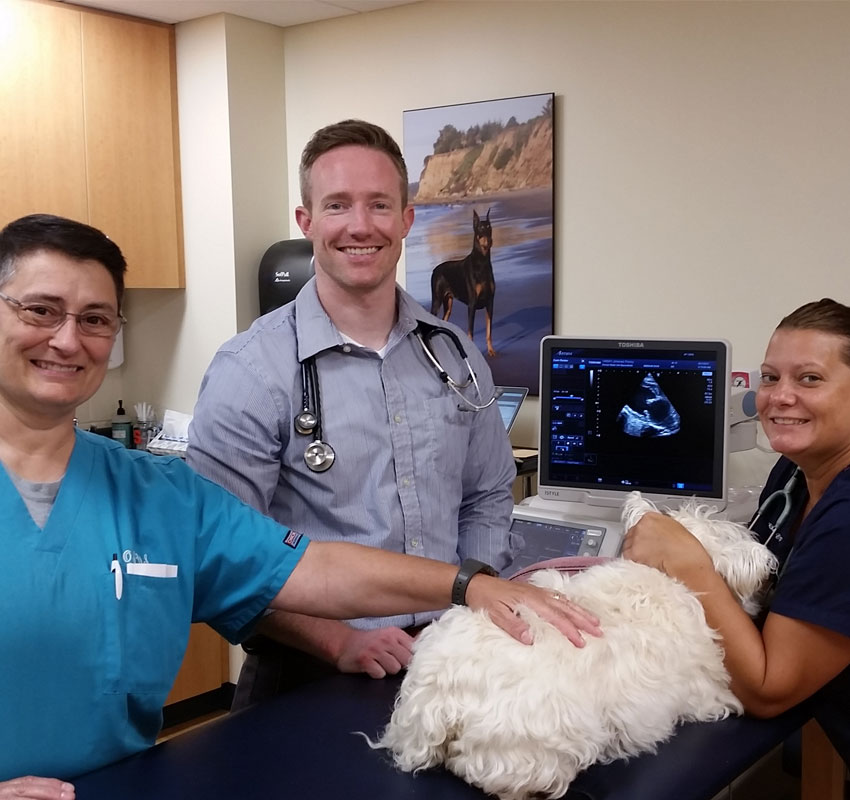What You Required to Know Concerning Vet Services: An Overview of Diagnostic Devices and Procedures
Vet services play an essential role in preserving the health and wellness of animals. Regular exams can expose concealed health and wellness worries beforehand. Different diagnostic devices and treatments, such as blood tests and imaging techniques, give crucial understandings into an animal's health. Comprehending these methods is vital for pet dog owners. What specific analysis treatments are most frequently used, and exactly how can they impact a pet dog's therapy strategy?
Relevance of Regular Vet Examinations
While numerous family pet proprietors might undervalue the value of normal vet exams, these consultations are vital for maintaining an animal's total health. Regular check outs to the veterinarian permit early detection of possible health problems prior to they escalate right into serious issues. Normal check-ups frequently consist of vaccinations, which are necessary for preventing infectious diseases that might drastically impact an animal's wellness. In addition, these appointments offer a chance for vets to assess the animal's weight, dental health and wellness, and general problem, ensuring that the animal is prospering. Throughout these visits, family pet proprietors can additionally obtain beneficial guidance on diet plan, exercise, and precautionary care customized to their details pet dog's demands.
Usual Diagnostic Treatments in Vet Medication
In vet medication, exact medical diagnosis is vital for effective therapy. Usual analysis treatments include blood screening methods, advanced imaging innovations, and urinalysis, each playing a considerable function in determining health issues. Understanding these methods enhances the ability to give ideal treatment for pet individuals.
Blood Evaluating Techniques
Blood screening strategies offer as necessary diagnostic devices in vet medication, allowing veterinarians to analyze the health and wellness of animals accurately. These strategies include collecting blood samples to assess different components, such as white and red blood cells, platelets, and biochemical pens. Typical examinations consist of complete blood counts (CBC), which evaluate general health and detect infections, and biochemical panels, which assess body organ feature and metabolic standing. Furthermore, serological tests can determine particular conditions via antibody detection. Blood screening is minimally invasive and gives critical info that assists in identifying conditions, monitoring wellness status, and reviewing reactions to therapies. Generally, these methods play a crucial role in making sure perfect treatment for pets and animals alike.
Imaging Technologies Used
Analysis imaging modern technologies are vital devices in veterinary medicine, enhancing blood testing techniques by supplying aesthetic understandings into an animal's interior frameworks. Typical imaging methods include X-rays, which serve for reviewing bone fractures and identifying foreign items, and ultrasound, which permits real-time visualization of soft tissues and body organs. Magnetic vibration imaging (MRI) provides comprehensive images of complicated physiological locations, especially in neurological assessments. Computed tomography (CT) provides cross-sectional images, improving analysis precision for various conditions. Each of these technologies help vets in detecting ailments, intending treatments, and keeping an eye on recuperation. By including imaging modern technologies, vet experts can much better analyze a pet's health and wellness and make educated decisions concerning their treatment.
Urinalysis and Diagnostics
Urinalysis acts as an essential analysis tool in veterinary medication, offering important insights into an animal's general wellness and assisting in the detection of different conditions. This non-invasive treatment examines urine samples to assess kidney function, hydration standing, and metabolic problems. Typical components analyzed include specific gravity, pH degrees, sugar, healthy proteins, and the existence of blood or bacteria. Uncommon searchings for can show problems such as urinary system infections, diabetes mellitus, or kidney illness. To improve diagnostic accuracy, urinalysis is often carried out together with various other tests, such as blood job and imaging research studies. Early detection through urinalysis can bring about timely treatments, boosting the prognosis for many vet patients. It is an essential aspect of detailed veterinary treatment.
Understanding Blood Examinations and Laboratory Evaluation
Understanding blood examinations and laboratory evaluation is vital in vet medicine as it assists in diagnosing numerous health problems in pets. Different kinds of blood tests offer vital information concerning an animal's interior state, while interpreting lab results calls for careful consideration of numerous elements. This area will certainly explore the sorts of blood tests available and the value of their results.
Kinds Of Blood Examinations
Blood examinations play an important function in vet medication, offering necessary understandings into an animal's health and wellness condition. Different kinds of blood examinations are used, each offering various objectives. Complete blood counts (CBC) analyze general health and wellness and find conditions such as anemia or infection. Biochemical accounts examine organ feature by gauging electrolytes and enzymes, supplying insights into metabolic health and wellness. Serological examinations recognize details antibodies or pathogens, aiding in the diagnosis of infections or autoimmune diseases. Blood inputting guarantees safe transfusions, while coagulation tests gauge the blood's ability to clot, important for surgeries. These tests collectively improve medical diagnosis, treatment planning, and monitoring of an animal's health and wellness, showing the relevance of thorough laboratory analysis in veterinary care.

Interpreting Lab Outcomes
An extensive analysis of laboratory outcomes is vital for exact diagnosis and therapy in vet medicine. Translating laboratory results requires an understanding of normal referral ranges and the value of deviations. Blood examinations can disclose various health and wellness indicators, such as body organ function, electrolyte equilibrium, and the visibility of infections. Vets must take into consideration the entire professional photo, consisting of the animal's background, checkup findings, and any type of symptoms offered. Variations in results might occur from aspects such as age, breed, and underlying wellness problems. Consequently, lab results should not be checked out in seclusion but rather as component of an all-encompassing analysis technique. Exact analysis enables for customized treatment plans and far better results for veterinary individuals.
Imaging Techniques: X-rays, Ultrasounds, and Beyond
Imaging strategies are necessary devices in vet medication, supplying critical Your Domain Name understandings into the health and wellness and health of pets. Amongst one of the most typically made use of approaches are X-rays and ultrasounds. X-rays are indispensable for picturing bone structures, helping veterinarians recognize fractures, tumors, or foreign objects. This method is fast and non-invasive, making it perfect for immediate situations.Ultrasounds, on the various other hand, utilize sound waves to create pictures of soft tissues and organs. This technique is particularly valuable for checking out the heart, abdominal area, and reproductive body organs, permitting veterinarians to assess problems like fluid accumulation or organ abnormalities.Beyond X-rays and ultrasounds, advanced imaging strategies such as computed you could try these out tomography (CT) and magnetic vibration imaging (MRI) are progressively utilized in vet method. These approaches provide detailed cross-sectional photos, enhancing the accuracy of diagnoses and therapy strategies. Cancer Veterinary Near Me. Generally, imaging strategies play a vital function in making sure effective veterinary treatment
The Function of Biopsies in Diagnosing Family Pet Wellness Issues
Accuracy in detecting health and wellness concerns in animals commonly hinges on using biopsies, which provide definitive details concerning tissue abnormalities. A biopsy involves the elimination of a small sample of tissue for examination under a microscopic lense, enabling veterinarians to identify numerous conditions, consisting of infections, lumps, and inflammatory illness. This diagnostic tool is essential for comparing malignant and benign growths, assisting treatment decisions, and examining the seriousness of a condition.Biopsies can be executed using numerous techniques, such as needle goal, incisional biopsies, or excisional biopsies, depending on the location and type of cells included. The choice of approach might impact healing time and the quantity of cells collected. Inevitably, the details amassed from a biopsy can bring about targeted therapies, enhancing outcomes for animals facing severe wellness challenges. Veterinarians emphasize the importance of this procedure in accomplishing accurate medical diagnoses and efficient therapy plans.
Advanced Diagnostic Devices: Endoscopy and CT Checks

Advanced analysis tools, such as endoscopy and CT scans, play a crucial duty in modern veterinary medicine, supplying non-invasive techniques to visualize internal structures and diagnose various conditions in webpage animals. Endoscopy includes making use of a versatile tube equipped with an electronic camera, enabling veterinarians to take a look at the stomach system and respiratory system directly. This technique can disclose irregularities such as tumors, foreign bodies, or swelling, making it possible for targeted treatment plans.CT scans, on the other hand, make use of sophisticated imaging innovation to develop comprehensive cross-sectional photos of the body (Board Certified Veterinary Cardiologist). This method is specifically useful for reviewing complicated structures like the brain, spinal column, and joints. By supplying high-resolution images, CT scans aid veterinarians in identifying problems that may not be obvious through typical radiography. Together, these advanced tools boost analysis accuracy, enhance treatment results, and eventually contribute to better overall animal health monitoring

Interpreting Examination Outcomes: What Family Pet Owners Need To Know
Understanding examination results can be a difficult task for pet proprietors, especially after innovative procedures like endoscopy and CT scans have actually been carried out. Interpreting these results needs an understanding of medical terms and a clear understanding of what the findings show concerning the family pet's health and wellness. Veterinarians commonly offer explanations, however the complexity of the results can still bring about confusion.Pet proprietors must actively take part in discussions with their vets, asking concerns to clarify any unpredictabilities. It is vital to understand irregular versus typical results and the ramifications for the pet dog's treatment strategy. Additionally, recognizing that some results may require additional testing or surveillance can aid owners remain educated concerning their family pet's health and wellness journey. Inevitably, a collaborative approach in between family pet owners and veterinary experts fosters much better health and wellness results and boosts the total care experience for pets.
Regularly Asked Concerns
Exactly how Do I Select the Right Veterinary Facility for My Family pet?
Picking the best vet clinic entails investigating regional choices, reviewing certifications, visiting facilities, and assessing team interactions (Cancer Veterinary Near Me). Focusing on referrals from relied on resources can aid guarantee the most effective treatment and atmosphere for an animal's health and wellness demands
What Should I Do if My Animal Rejects to Go to the Vet?
When a pet dog declines to head to the vet, it's a good idea to remain tranquil, usage deals with or toys to lure them, and consider scheduling a home visit if anxiousness lingers. Persistence and favorable support are crucial.
Exist Telehealth Options for Vet Providers?
Telehealth alternatives for vet services are progressively readily available, permitting family pet owners to speak with veterinarians remotely. These services enable discussions regarding health and wellness worries, recommendations on minor disorders, and follow-ups without needing to check out a clinic.
How Often Should My Family Pet Have Dental Check-Ups?
The frequency of dental exams for family pets usually depends upon their age and type. Normally, vets recommend yearly dental assessments, although some animals may need even more regular sees to preserve ideal dental wellness.

What Are the Expenses Connected With Vet Diagnostics?
The expenses related to vet diagnostics can differ commonly, typically ranging from standard examinations like blood job to advanced imaging strategies. Factors affecting expenses consist of the clinic's area, devices utilized, and specific tests required for each and every family pet. Veterinary services play an important function in preserving the health and wellness of pet dogs. While lots of family pet owners may ignore the value of normal veterinary exams, these visits are essential for preserving an animal's overall health and wellness. Additionally, these visits provide an opportunity for vets to assess the animal's weight, dental health, and general condition, guaranteeing that the family pet is thriving. Accuracy in identifying health and wellness issues in pets often hinges on the use of biopsies, which provide definitive info concerning tissue abnormalities. In addition, acknowledging that some results might require additional testing or surveillance can aid proprietors stay educated concerning their animal's health and wellness journey.